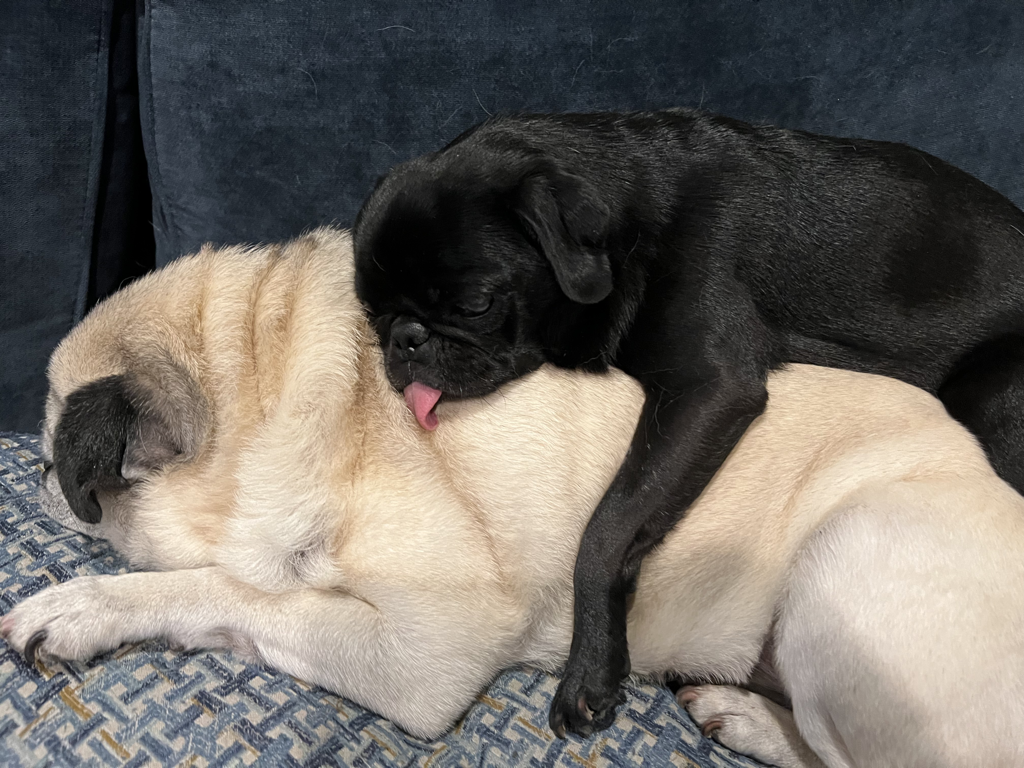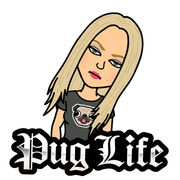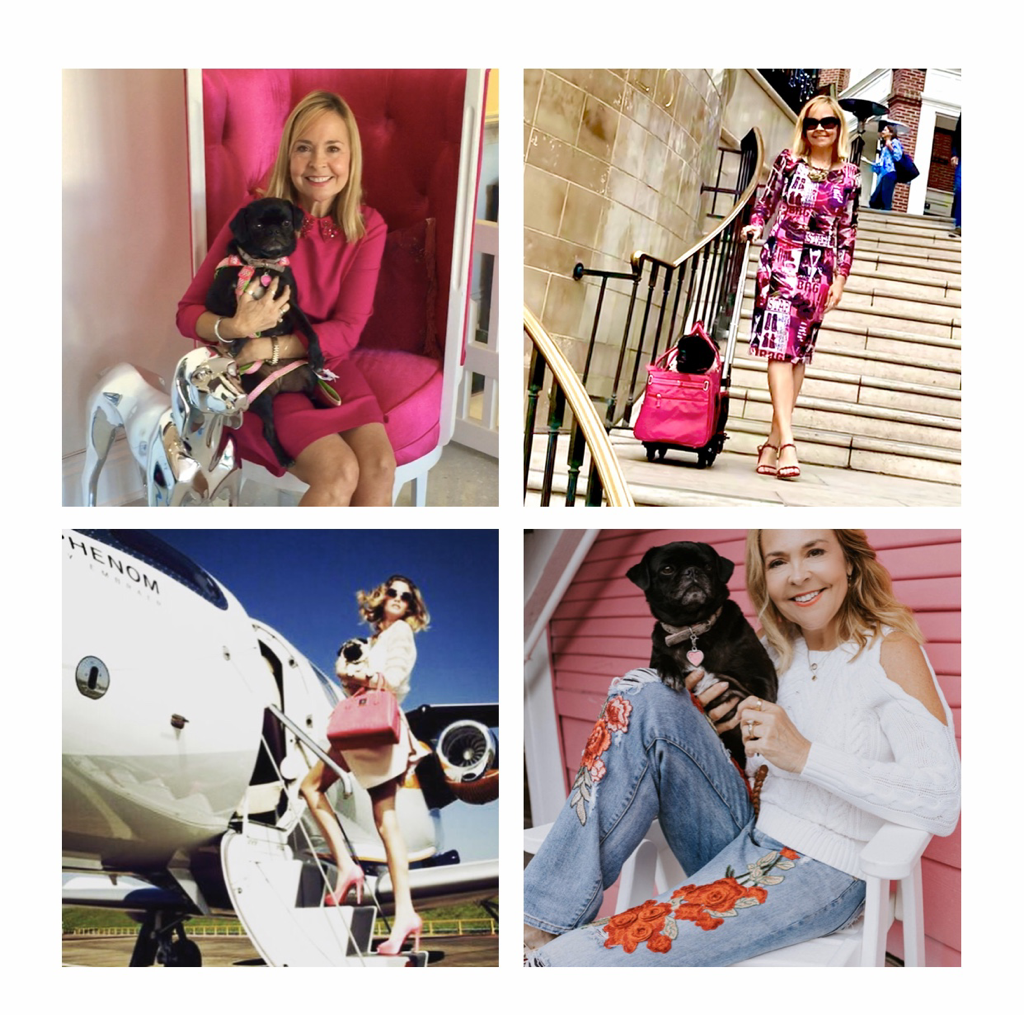|
By, Katy Cable-The Weekly Runt
So you’re thinking about getting a second dog. Are you envisioning a new BFF for your current dog? Imagine a playmate to keep them company when you’re not around. How great to have a buddy for them to run around and play with. A new pal to cuddle up and snore with on the dog bed at the end of the day. But wait… How do you know they’ll get along much less be best friends? We all have people in our lives we put up with simply because we have to. We certainly don’t like and become best friends with everyone we meet. Dogs are no different. Just because you fell in love with another dog and want to bring them home doesn’t mean your current dog will. The good news is, by following these effective tips, you can offer them the highest odds for a successful companionship. FIRST THINGS FIRST…ARE TWO DOGS BETTER THAN ONE, OR JUST DOUBLE TROUBLE? Before you run out and fall in love with a new dog, consider your motives. Is it really going to be better to have two dogs? While I’m the first person to admit, for me, pugs are like potato chips…you can’t have just one. I’d like to own a ranch and have so many I’d be tripping over them. The reality is, I don’t have the time, energy, or resources for more than one pug right now. Having two dogs might be great for you, but a bad choice for someone else. Consider everything that goes into owning two dogs. It’s much more than just adding some kibble to the grocery list and picking up a bit more dog poop. There can be expensive and time-consuming training, pet-sitting/boarding costs, and don’t forget vet bills which can add up faster than a dog devours a bone. And, if you think adding another dog will tame some of your current dog’s behavior issues, think again. Those bad behaviors are most likely only going to get worse when getting a second dog. Think about your living situation right now and whether the timing is right. Read my blog: A New Addition. If you have a big work project, a house remodel, or other important events happening, it might be best to put off getting another dog for the time being. If it’s all systems go, read on: FIND A GOOD MATCH: Try and find a new dog that will compliment and match your current dog’s energy and personality traits. Think about your current dog. Are they fearful or do they have anxiety issues? A perfect companion may be a very relaxed, easy-going, chill dog to help calm and ease them. Is your dog a senior or low-energy dog? If so, bringing in a puppy or high-energy dog may drive your current dog bananas. Puppies like to play, bite, chase, climb, and crawl. They will not leave your adult dog alone. In this case, look for a 3-5-year-old dog or even another senior dog. DON’T FORGET GENDER: Typically dogs of the opposite sex get along better than dogs of the same sex. I highly recommend adopting opposite sexed dogs. When that is not possible, the second best option is to have two males. Two females are the most likely to have issues. Especially if one is a black female pug. In my experience, these seem to be the most alpha and difficult. BE CAUTIOUS OF SIZE: Mixing a toy, or small breed dog with a larger dog can be tricky. Even simple dog-play can be outright dangerous. It’s easy for a smaller dog to be hurt by a larger, heavier, dog. A smaller dog may act aggressively towards a much bigger dog, or worse, the larger dog acts out. Ideally, stick to dogs around the same size. MEET AND GREET: I recommend scouting the rescue or shelter and selecting a few options. Talk to the volunteers to get a feel for the prospective dog’s temperament. Plan to meet at a neutral location for a walk with the new prospective dog. Avoid setting up the meeting in your dog’s (or the other dog’s) territory, which may make the dogs feel an intruder is coming in. Your dog should meet new dogs one at a time, as group meetings can be overwhelming. This is one reason why some dogs don’t do well at dog parks. KEEP CALM AND CARRY ON: Your dog will sense your emotions about the meeting and respond in suit. If you’re nervous, stressed, or overly excited, your dog may be too. A better option is to stay calm, breathe slowly, and portray a relaxed attitude to your dog. AVOID BRINGING TOYS AND TREATS: Meeting a new dog is stimulating enough — add in treats and toys and the situation can quickly escalate out of control. Plus, your dog may feel possessive about the food and treats, leading to issues between the dogs. Use lots of praise and pats on the back for positive reinforcement. SHORT AND SWEET: A few minutes is long enough for an initial interaction between two unfamiliar dogs. It keeps the meeting fun and interesting while leaving less time for things to get tense. For dogs that are easily stressed, a short meeting will be essential to keep your dog from feeling overwhelmed. Better to have a few short positive interactions than a stressed out dog getting anxious and aggressive. LET THE DOGS OUT: Sometimes a dog will urinate when meeting a new dog, and then walk away to help diffuse tension. The other dog can then sniff the urine and get to know the other dog this way before coming into closer contact. If the meeting is indoors, housetrained dogs will probably avoid urinating and therefore miss out on this important method of introduction. A MOVING INTRODUCTION: If you walk purposefully during the introduction (such as between two dogs on a sidewalk), it helps prevent the meeting from getting overly intense. Put both dogs on leashes with separate handlers. Bring both dogs into the meet area and carefully observe their body language. This is a great indicator how to proceed. Ideally, both dogs are wagging their tails and eager to engage. If they seem calm, try walking them around together at a comfortable distance. If all goes well, slowly bring them in closer together. Observe them closely while doing this, and do not force a greeting if there is extreme stress or signs of aggression. Reward both dogs for a nice interaction by giving lots of praise LET THEM ROAM: After a successful walk, find a fenced yard or contained area to drop the leashes and let the dogs approach each other. (Leave the leash on, however, in case you need to grab it to diffuse tension). DON’T HOVER OVER YOUR DOG: You may want to stay close in case something goes wrong, but hovering over your dog will add to his tension. You should give the dogs space to say hello, and if the situation seems to be getting too stressful, move away from the dogs to lower arousal. Hopefully you have a positive experience and can move to the next TEST DRIVE phase. If not, repeat the steps above with a different dog or at a slower pace. Remember, most dogs are social animals but they don’t all get along well with others. You may end up with two dogs that co-exist instead of BFF’s. TAKE THE NEW DOG FOR A TEST DRIVE: The next step is to take the new dog home for a test week. Most good breeders and adoption/rescue organizations are flexible with the initial try-out period. In fact, they are usually willing to take a dog back, even when things do not work out long term. After all, everyone wants what is best for the dog. BRINGING HOME THE NEW DOG: These steps are very important to keep the balance in your house. I learned about this process when I first started fostering. The rescue insisted we keep our foster dogs separate from our resident dogs for a minimum of 24 hours. I’ll be honest, when I first heard this I thought they were crazy. How was I going to possibly keep the dogs separate for an entire day! But they are right; it really works and creates a much smoother transition. As hard as it may seem, these steps help create a SAFE, calm, and balanced transition. Even the most chill, happy dogs can get stressed when another dog enters their domaine. It’s only 24 hours… one day of separation that can change the relationship of your dogs forever. WHO LET THE DOGS IN: Do not allow the new dog to run loose in your house yet. Keep them on a leash. In fact, I recommend keeping them on a leash until you get to know their behavior inside the house. Use a bedroom or a baby gate to designate a special area in your home for the new dog to relax and adjust to their new surroundings. I recommend putting a crate with the door open (or off) in this area so the dog has a safe, quiet retreat. After 24 hours of separation, if both dogs seem to be calm and easy going, you can move to the next step. If not, remember, your new dog is experiencing a lot of new things and is likely stressed out. If your current dog won’t give them space, or either dog seems agitated, consider a longer separation. SECOND OR THIRD DAY WITH YOUR DOGS: After the separation period, now that both dogs are calm and have had time to settle, you can start the introduction stage. You need someone to help you with this step. Never introduce your new dog inside your house. If you have more than two dogs, introduce one dog at a time, beginning with the most easy-going dog first. Start by taking both dogs out for a long walk. Keep your current dog in front with you, and have the newly adopted dog behind with your helper. Begin the walk in a single file, not side-by-side. Slowly begin walking parallel to each other about 10 feet away, gradually working your way closer together. After a good long walk, if both dogs seem calm, allow them to do a background check (sniff each other’s rears…it’s a dog thing). Keep these first interactions short and sweet. Don’t overwhelm either dog with too much sniffing. Closely watch their body language. If you notice showing of teeth, growling, stiff erect tail, stiff body stance, or ears back, give a firm NO, and continue walking. Do not allow things to escalate! If you see ANY of those signs, separate the dogs and start to walk again. Repeat several times until everyone is calm. Once this first walk is successful, you may go on to the next step of bringing the dogs inside the house. WELCOME TO MY DOG HOUSE: The resident dog should be allowed to enter the home first, and then welcome the new dog inside. You can take down the baby gate now and give your new dog a little more freedom. I still recommend keeping the new dog separated for at least a week, gradually increasing their time together. If you have a fenced backyard, this is an ideal spot to give the dogs some playtime together. Keep these sessions short. You don’t want to overwhelm either dog. Gradually, allow both dogs to come inside and investigate. For the first few weeks limit their together time depending on how they are adjusting. Never leave the two dogs alone. If you cannot closely supervise, then put them in their crates or separate rooms. LIFE WITH YOUR NEW TWO-PACK: Continue taking a lot of long walks together as a pack. Keep both dogs tired by giving them more than enough exercise. A bored dog equals trouble. For the first few months, be very aware and don’t let your guard down. Continue watching for any signs of stress in either dog. If you notice either dog is getting agitated or overwhelmed, reduce the time they have together and slow it down even more. REMEMBER, a newly adopted dog is under a tremendous amount of stress and possibly fear. Your current dog is wondering who this new dog is, and what the heck they’re doing in THEIR territory. Mix these intense emotions together and you can get a dogfight quicker than a cheetah can pounce on a limping gazelle. This is not because either dog is aggressive, but rather it takes time for both dogs to settle and adjust to a new living situation. RESOURCE GUARDING: Is the guarding of people, food, dog beds, toys, or any object the dog wants to claim. Until I rescued my current pug Olive, I had no idea what this was. Once I saw my normally sweet little Pug, try and tear the face off of another dog approaching me, I learned this term firsthand. Wow! It took me completely off guard. If your dog has never had another dog in the house, or you’ve never had a rescue/shelter dog, or a food-motivated Pug, you may not know about resource guarding. Now is the time to learn your dog’s body language. Watch for a showing of teeth, growling, a stiff erect tail, stiff body stance, ears rolled back, and/or wide bulging eyes. If you have a resource guarder, then you will need to be super vigilant on feeding time, bones, toys, dog beds, or whatever your dog likes to guard. Even if you don’t think either dog is going to resource guard, I still highly recommend having separate feeding areas and keeping special toys out of the other dog’s reach. I wish you the best of luck with the new addition to your pack. Having two dogs can certainly be double the love and double the fun! Leave a comment below and let me know all about your new dog and how the introductions went. Do you have additional tips to share with the pug community? |
PARTNERSHIPS
...Let’s Work Together
I love collaborating with other influencers and brands! Whether you need assistance with social media, creating an unforgettable event or want to be featured in my nationally syndicated blog, I can help. Let’s talk!


